Boost Your Sales With Better Product Photography
“Good” product photography is the first step to getting a visitor to stay longer on your site, to click through, to learn more about what you do, and hopefully pull the trigger on a purchase.
But what exactly is good photography, and how can you take professional images at home without investing in expensive gear?
To answer that, we've invited photographer Ben Waugh, an Aussie who is now living the #vanlife dream, being his own boss, creating incredible visual content for major brands, and photographing some of the world's most scenic locations.
Listen to this episode to hear Ben share what 'good' photography actually means, what to invest in when it comes to photography gear and how we can improve our product shots with lighting and a couple of sneaky little tricks that make more sales.
As always, we hope you enjoy the podcast, and if you do, please consider subscribing.
We also got you covered for all things ecommerce, dropshipping, and entrepreneurship over at the Oberlo blog.
Prefer a summary? Here's a seven-point TL;DR version:
- If you're happy with your smartphone's photo quality, there's no reason to switch to DSLR.
- To fix shadow issues, set up your shoot closer to a light source or use an additional light to fill in shadows.
- If you're struggling with lighting, hang up a white sheet or apply baking paper over the window or light source to diffuse the light.
- Set your scene properly before shooting to reduce editing time and the less editing, the better.
- Ensure colors aren't too different from the product's actual color and that lines in your photos make sense.
- Take photos of your product from all angles and its details, too.
- Text on photos does not look professional.
Start Yours is a podcast about ecommerce, dropshipping, and all things launching a business.
Join us as we meet entrepreneurs who have gone through the triumphs and headaches of running an online store, and learn how they managed to survive and thrive.
David: So to start off, I’m curious where you are right now. Describe what is around you as we talk.
Ben: Yeah, so I am currently on Vancouver Island in British Columbia, Canada renting some beautiful land off a local here on the islands and we basically have a five-acre rainforest to ourselves, which is pretty incredible.
We’re super close to town, but it feels like we’re in the middle of nowhere. We have a beautiful creek running by outside. I can see at the window as I’m talking to you and it’s just a really peaceful calm, quiet spot and it’s absolutely gorgeous here. So, very lucky. We’re about half an hour from the beach on the north and the south coast.
David: Nice, but you’re not from Vancouver Island so I wanna dig into how you landed there and specifically the work steps that led to you being on this remote island on the western coast of Canada.
So you quit your day job a year or two ago, and you joined the van life community, #vanlife. So talk me through the process of taking this leap from 9:00 to 5:00, to really living off the grid. I mean, literally off the grid as in the Canadian Rockies and rainforest and whatnot, it seems like going from an office gig to 100 percent freelance exploring North America in a van, that would seem like a pretty big shift. So walk us through it.



Ditching a Comfortable Life
Ben: Yeah, it’s definitely very different from what I expected. So, a couple of years ago, if we go back, I was a graphic designer in Australia, I finished university and like most people, I jumped straight into working and I would start to be using my degree.
And while I enjoy graphic design, I did it for a couple of years and I wasn’t really satisfied. I think I just kinda fell into the normal of you get a good job, you earn good money. and then you get ready to buy a house and all those kinds of things.
→ Click Here to Launch Your Online Business with Shopify
So I got quite comfortable in where I was living and how I was living. I was a typical 22-year-old dude who was doing financially well. I had a nice car and a motorcycle, and I was about to buy a house, and I just decided one day that maybe that wasn’t what I wanted. I think I saw a few of my friends traveling at the time and in particular one was in Canada and I thought, “Man, if she can do that, why aren’t I doing that?”
And yeah, I quit my job, which was a really well-paying job. My parents were very confused, and I bought a one-way ticket to Canada, and I didn’t really have a plan.
I sold everything I had in Australia. I donated a lot of my clothes to charity and I pretty much have one of those big plastic bins left at mom and dad’s house and that’s it.
Yeah, so a one-way ticket to Canada. No plan, no job, no friends, and I just thought I’d figure it out. And the whole concept, I was saying to my mom and dad was, “No plan, no worries,” and they weren’t really on board with that, they were pretty worried.
I landed in Banff Alberta which is pretty much the heart of the Canadian Rockies. A lot of people know Banff, it’s an absolutely stunning area. And I’d seen a lot of photos from there and I think that’s what really drew me there.
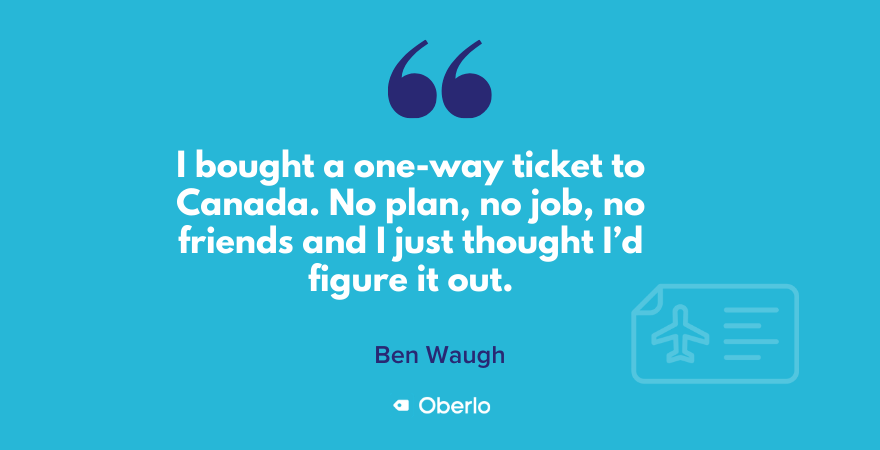
I had been into photography for a few years just as a hobby. I got into it through my dad who used to be a photographer and I was like, “Oh cool. It looks like a beautiful spot. I’ll stop my travels there and maybe I’ll just figure it out and see if that’s somewhere I wanna live.” And I got to Banff and I was just blown away by the mountains and they’re absolutely incredible.
And yeah, I booked a hotel or hostel for two weeks and that was the only plan I had. I knew I had a roof over my head for two weeks and I had enough money in my savings so it could probably get me through to maybe three to six months of rent if I didn’t get a job.
And I figured if I was there for that long and I couldn’t find a job, there was something wrong and I should probably go home.
David: And what was the tipping point that made you sell your stuff, donate your clothes, and all that? You said that one day you made this decision and I’m curious. Was it literally a one-day thing where you just kind of… I don’t know, had an epiphany?
Or was this something that you kinda feel bubbling up, that despite the good job, despite what looked from the outside like a pretty comfortable existence, it just didn’t quite feel right and then it felt a little worse? Was it all of a sudden, or was it something that was percolating over time?
Ben: I think the decision to do it just kinda came up immediately. There was one day, I was like, “Man I wanna do something else, I wanna do something more. What should that be?” And the idea hit me to just pack up everything and go overseas and figure it out.
But the actual process of that as anyone who’s traveled before knows that it doesn’t quite work that way. So obviously, like having a job, you have to give a certain amount of time to say you’re leaving and then organize your flights and everything else. So there was a lot… It was a long enough process, I think it was probably about four months and I had to apply for a work permit in Canada, too, so all of that adds into it. But the actual decision that I wasn’t content with my life and I wanted to change it pretty much came in the span of a day or two.
It just hit me like an idea and I was like, “Man I’m gonna do this, this is gonna be sweet.”
I think a lot of my friends really didn’t expect me to follow through with it, to be honest, they were probably just like “Ah, it’s another one of Ben’s crazy ideas, he won’t do that, he’ll probably stay.” And yeah, here we are a couple of years later.
David: You talked in one of your YouTube videos about some of the… I don’t know, the annoyances with living the lifestyle you do. So, this digital nomad thing where you’re not always sure where your next paycheck will come from and who your next client will be, or when that paycheck will arrive when you do land the client, ’cause not everybody is always timely with filling out those invoices and after having ticked off all these headaches in this video, you said,
“But these kind of weird elements that go into it, the uncertainties, I thrive on that, I love it.”
So I’m curious, you had the opposite of this situation where everything was pretty secure, pretty stable, you didn’t have to worry about the paycheck and you didn’t have to worry about the employer.
How did you come to love it? How did you come to thrive on what some people might look at as quite a headache?
Ben: Yeah, it’s definitely an interesting flip, that’s for sure. Now that you’ve said it like that, it makes me think about it a little bit more. But I think it’s maybe not like the fight or flight kind of thinking, but it definitely keeps you on your toes.
I think it really pushes you to work hard. It’s so easy to become stagnant or lazy when you go to your job, you get paid to be there, you go home and that’s that, and you get paid. But when you actually have to actively seek income, I think it motivates you more to work.
And as long as you’re doing something you’re passionate about, it’s gonna go hand-in-hand and work really well for you. But yeah, I think that’s why I love it. It’s very much like you’re pursuing something more if that makes sense.
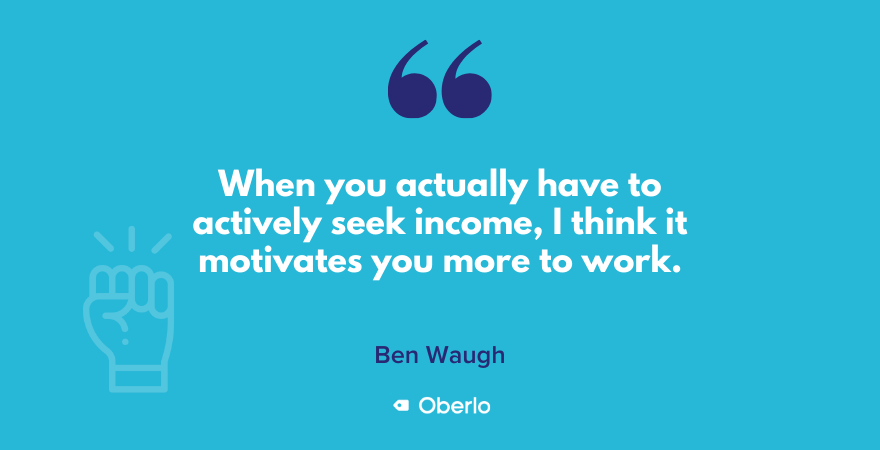
Finding the Rhythm That Works
David: Yeah. And working for yourself, it seems like it could sometimes be not so easy setting stable work hours and you’re always on call, you have to be available. How do you manage your time and maintain that work-life balance?
‘Cause I know, on the one hand, you don’t wanna be stagnant, you don’t wanna be lazy, but then, on the flip side of that, you also don’t wanna always feel overwhelmed.
Ben: It’s definitely an interesting way to… Interesting to figure out. It’s very different and complicated, I suppose, for me, living in a van with my partner. And we both do the same job, we’re both commercial photographers and content creators, but we both work very differently.
So for me, in the morning, I need to wake up, immediately start work, or have a coffee, start work, and get my brain going. Whereas for her, it’s a slow morning and then starting work later in the day. Yeah, it’s all about what works for you and I think you have to just try a couple of different ways and see what makes you feel the most comfortable and the most productive.
But when you’re moving and traveling, it does add another layer of complexity to that, depending on where you are.
Maybe you have restrictions on times you can do things, or things like that when you’re traveling. Especially being in a van, sometimes the internet is an issue, depending on where you’re parked as well.
So, you might have to plan your day around driving to Starbucks to get some Wi-Fi for a little bit to do some emails or do some work, or to go to a certain location to shoot, and things like that. But yeah, I think it’s just a matter of trial and error and figuring it out.
Smartphone or DSLR
David: Awesome. You mentioned work, so let’s dig into that. You are a professional photographer, this is how you pay the bills on the van, I guess. And I wanna take your pulse on a few photography-related things that we hear about all the time.
First up, when does someone need to level up and invest in a high-end camera? When should somebody graduate from a smartphone? I guess, to narrow that down, give you some things to chew on, what can you do without a really nice camera?
And then on the flip side of that, what are the perks of, if you do wanna invest in the hardware to take immaculate pictures, what are you gonna be getting that you don’t get with your standard smartphone setup?
Ben: I think that there’s not really a distinct time to upgrade. I think it’s more so of a… You’ve gotta want to do it and you have to have a… You have to know in yourself that you have a need to do it or you have a desire to learn it more. Because there’s no point in going out and spending any amount of money, whether you’re buying a very cheap entry-level camera or a very high-end camera.
If you don’t have the drive to actually practice using it, it’s pointless.
And you’re not gonna learn it and you’ll probably get frustrated and leave it in the cupboard, or sell it and decide that it’s not for you. So I think the time to switch from maybe a smartphone to a digital camera, or something else would be that when you know you want it, or when you’re gonna be going traveling and you really want some better quality images or maybe you want better quality images for work or something like that too.
But there are still a lot of things that you can do with a smartphone compared to a DSLR, or a digital camera. Especially in the last couple of years, phones have just gotten absolutely incredible.
Years ago, you wouldn’t have this conversation at all, it wouldn’t even be a question. It would be like, you go buy a camera… A full megapixel camera on the back of your phone is not gonna cut it, go buy one.
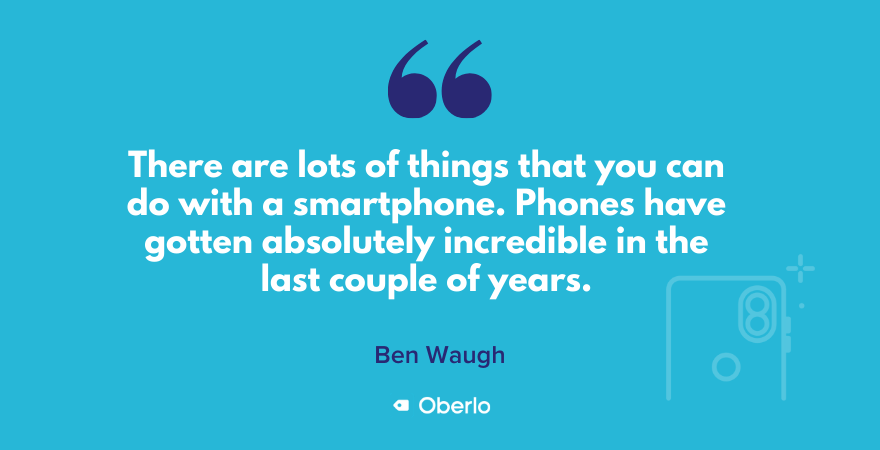
But yeah, it’s pretty incredible now, there’s a lot of people out there who are doing… I know some people who are doing commercial work, doing product photography on their iPhone, which blows my mind because I do that on a camera that is definitely not an iPhone. It’s much chunkier, much more expensive, a lot heavier to carry around. And I think if you know how to use it, then you can still make a living with it if that’s something you wanna do.
But yeah, I think the main differences are the depth of field is a very, very big thing. So the depth of field is basically the object that’s in focus or in front of you will be in focus and the things behind that might be blurry.
It’s kind of like portrait mode on an iPhone. People will probably understand what that is the easiest. Having the ability to interchange lenses on a camera is very, very advantageous because it can help you what your perspective is or maybe how the shot’s composed. Or a ton of different things.
And while phones these days might have two or three cameras involved, or different lenses on the phone, it’s still not quite the same quality that you would get from a digital camera, or a DSLR.
So I think there are a lot of uses for an iPhone or for a phone as well. They can obviously fit in a lot of smaller places that cameras can’t go, which is really, really helpful, which is why the GoPro did so well. But being able to put your phone somewhere that you can’t put your DSLR is a huge advantage.
So yeah, there are a lot of pros and cons to both. Obviously, a phone is probably enormously cheaper and people probably have one already. Whereas a DSLR, they can be quite heavy, to buy a different lens it can be very, very expensive and it doesn’t fit in your pocket. So you don’t… Unless you have a backpack on, you probably don’t have it on you all the time. So you can’t just see something and be like, “Oh I want a good photo of that. Boom, I’ve got it.”
So yeah, I think if people have got an iPhone, or a phone and they’re content with the photos they’re getting from that, there’s no reason that they need to upgrade to a digital camera.
It’s only if they see a purpose for it I think. And then there’s gotta be a desire to wanna learn it because then that’s how you’ll get better at it.
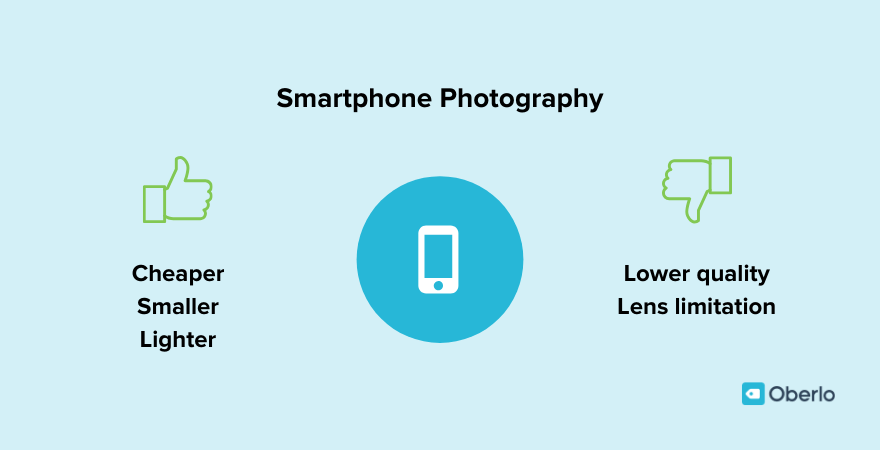
Tackling Issues With Shadows
David: Sure. We did an article on how to take product photos with a smartphone and we have lots of good examples and we walked through some of the free photo editing software that you can use and it was a really solid example-filled article where we showed people this is what to do, this is how to do it, this is how to optimize it, etcetera.
But then in the comments, someone asked,
“How does the photographer keep their shadows out of the picture? What if natural light is not the issue, but when you try to do a close-up of the item and your camera or body casts a shadow on the white background you’re using. How do you avoid this?”
And for as good as the article was and as good as the other comments and other feedback was, we had no freaking idea how to answer this question. And I think this is something that a lot of people run into when they’re taking photos for their websites, especially with product photos, if they wanna get right up close, right up into it, the lighting is gonna… It’s important, it’s vital, but it’s also gonna create its own issues.
And so what can you say about this lighting issue and how to have on the one hand good solid bright lighting and then the other hand, avoid any of these shadow issues that a lot of people who are building up websites run into?
Ben: Yeah, if you’re using a little mini-set that maybe you’ve set up in your house or your office, you can… If you set it up in a way that you can rotate that, you might be able to turn it towards the light a little bit better, or maybe you go closer to the windows so there’s more light filling in.
But something I use a lot is like a little fill-in light, it’s about the size of your smartphone and it’s pretty bright so you can change it to be like a warmer light or a cooler light and you can hold that and move around with your hand ’cause it’s quite small and you can actually use that to fill in the shadows.
So if you’re leaning over something and the shadow is cast by your body, or maybe your phone or whatever you’re holding, you can fill in those shadows with an additional light. But you obviously don’t need to go out and purchase a light like that.
You could use a lamp shade or like a ton of different things. You can use someone else’s smartphone with the flash on.
There are a ton of different ways that you can fill in that light, that’s a really good way to do it. But maybe a combination of filling in the light and rotating your set, or maybe changing the angle you’re on or the time of day you’re shooting depending on where the sun is, there’re so many different ways that you can get around that.
Tips on Creating a Setup for a Photoshoot on a Budget
David: Mm-hmm. And you mentioned a home set up there and I’m curious. How would somebody go about creating that home studio setup for product shots, for example, that is versatile and it has the ability to adapt as you said, but also not gonna break the bank?
Ben: Yeah, some really easy ways to do it is if you wanna… For example, let’s just say a pure white background on Amazon and plenty of other places like that. You can find these lightboxes which you could buy if you wanted to do that. They’re pretty cheap. It’s basically like a white bed sheet turned into a cube with some lights inside and you could pick that up and move it. It’s probably only a couple of feet by a couple of feet and you can pick that up and move it wherever you want.
Another option you can do that’s super easy is any of your local stationery stores, or something like Staples you can go to and just grab an A3, like a big piece of white card, you could set that down flat and then put the second one behind it as your background and then when you have those two you can move those wherever you would like and you could use that for your lighting, a bunch of different things. You could put some on the side if you really wanted to.
But a really good tip that I always give people when they’re struggling with lighting or trying to get lighting at home or in their office wherever it is, is sometimes light can be quite harsh and it casts very hard shadows and this is definitely so many people would notice in the example where you’re like leaning over it.
And a really good way to get around that is by hanging up a white bed sheet or maybe some baking paper over the window or the light source and basically, it diffuses the light or makes it softer and you wanna get some really harsh edges.
So if you compare it to looking at the shadow of a tree in bright sunlight versus early morning. With bright sunlight, you’re gonna see a very clear outline of the tree whereas early morning you barely have a shadow at all or maybe if you have a shadow, it’s got very soft edges. So by softening that light, it enables you to have nicer shadows and cleaner shadows and you play with a light a little bit more.
So if you combine your diffusion of your light with maybe a bit of a background, it can make your job a little easier, so your set might not be as important. But yeah, creating a little set at home could be super easy. You could set some cards up against the window, lean it up against some books, water balls, like whatever you wanna lean it up against you could do that, or you could build something out of a cardboard box and put it inside that. There’re so many simple ways to do it.
There was a particular product shot idea a few years ago as I was shooting a smoothie and the photos turned out absolutely beautiful and the client asked me how I’d done them and I showed them the behind-the-scenes and they were really, really surprised.
I had the smoothie on a wooden cutting board and just in front of the smoothie, I had some granola and some berries, and things like that. And behind it, about a foot and a half behind the smoothie, I had this disgusting dirty greasy oven tray, like the bottom side of it. And when that was out of focus, it had this beautiful texture to it that it really made this purple smoothie pop. But when you look at it as a finished photo, you would have no idea that it’s a cutting board next to a window with a dirty oven tray.
So sometimes it’s a matter of trial and error and just figuring out what looks nice in the photo because, through the lens, you can make it look very different from what it actually is in real life if that makes sense. So you don’t need to have this crazy fancy elaborate set at your house. It could be something that looks pretty janky from the outside but does the job. It’s not… You don’t need to have a beautiful, big, fancy set.
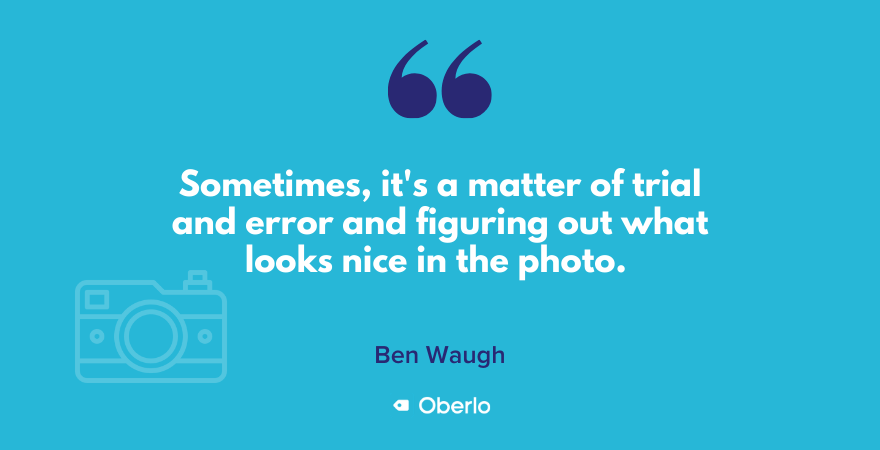
Photo Editing Advice
David: Sure, all you need is a dirty oven tray. That’s beautiful. And you brought up the photo box, I should just point out while we’re talking about it, that Oberlo users use that while you set up your product photos, but you can also sell those, those have been hot-selling items for Oberlo users for at least a year or two now so those are just…
I wasn’t expecting to talk about trending products here but because it came out, those are actually really good products to sell, to dropship so go search for those if there’s anything related to photography at your store.
So you mentioned beautifying pictures after the fact and I wanted to dig into software. What can you say about how a novice, somebody who’s not seasoned with Photoshop and some more high-end software, what should they do to make their pictures as good as they can be?
So once they have the raw pic, what can be done after the fact? How do you do it? What are the programs that can be used? What about the post-production stage of the process?
Ben: Yeah, I think the two massive pieces of advice that I can give to people. If you’re taking your own photos and you’re not super familiar with the fancy expensive editing software, number one is actually during the photoshoot or when you’re taking your photos, this one’s really important because the nicer your product looks, like, there are no fingerprints, there’s no dust, there’s no dirt, you’ve got things straight, you’ve got things in line, things like that, the nicer you set that up on set or like when you’re taking your photos, it’s gonna make it way easier for yourself when it comes to editing time because you don’t have to do as much work.
So for example, if you’re shooting a really shiny product and the way the lighting is, you can see the light reflected and it’s quite a strong glare. It’s gonna be very, very hard to edit that out even in something like Lightroom or Photoshop.
So maybe just looking at the scene for a few more seconds before you take that photo and really have a look at it, it’s gonna save you a lot of stress and a lot of time later and you probably won’t need to edit that anywhere near as much.
The second piece of advice is that less is more. And I think this is something a lot of people don’t realize when they’re early to photography and editing. The saturation doesn’t need to be at 100, like, you don’t need to crank that all the way up. Less is more and it’s really important, especially if you have an online store, to keep your colors realistic.
And so, the less editing you can do the better.
So maybe just use, like you can get away with using the editing software in your phone or whatever is built into the device you’re using. The options that you have in that are probably still gonna do the job quite well.
So you could just be upping the colors maybe a tiny bit but just make sure that it looks real and authentic to what it would look like when a customer actually purchases that because that’s super, super important.
And I’m sure plenty of people in their own experience have bought something online and it’s not exactly what they thought it was when it got there, or maybe the colors weren’t right or something like that. So, really important for the consumer to be receiving the product that they’re expecting. So, less is more when it comes to photos, and try and keep it as real as possible.
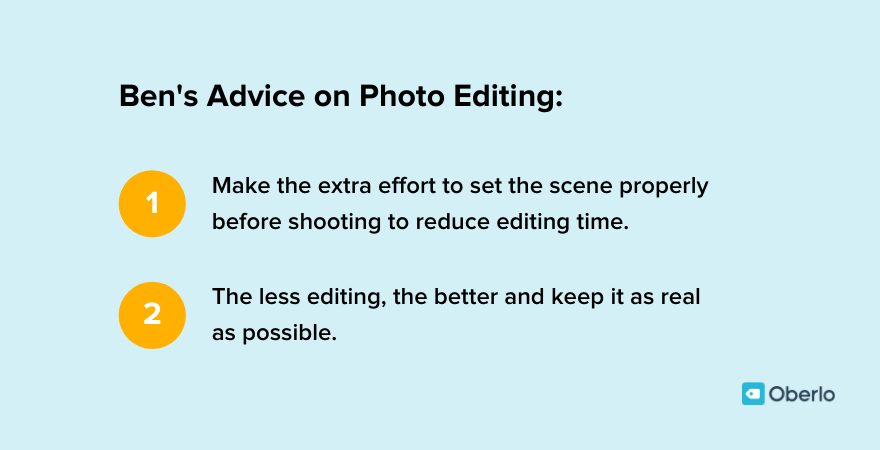
Common Product Photography Mistakes
David: Yeah, that’s a customer service nightmare if you’re doctoring the photos too much and the product doesn’t look anything like it does on the website.
What are some of the common mistakes or errors that you’ve seen in product photography when it comes to ecommerce and online stores? Errors that are maybe easy to fix, that you see them and you just think, make you wanna scream because it was a fixable issue.
Ben: Yeah, I think that number one is color. Honestly, there are a lot of times where my partner has bought clothes online or I’ve bought stuff online and it’s not the right color, which doesn’t sound like a huge deal when you’re posting it and you’re like, “Oh well, it looks good on my store and maybe it looks greener and that’s awesome ’cause people look at it,” and then when it arrives, it’s almost like an off gold color and people aren’t gonna be stoked to that. So obviously that’s a bit of a logistical nightmare. But yeah, it is interesting when you’re looking at stores, kinda like analyzing how different people do stuff.
But I think color’s a really big no-no, be really careful with that. Look at it on maybe a couple of different devices and things like that.
But I think one of my biggest pet peeves is horizon lines and vertical lines. So having a flat horizon in a landscape photo or whether it’s a product photo… Like if it’s evident that… Let’s say it’s a glass that you can see the liquid inside and if that liquid is not sitting flat like for example, your horizon line or the line that should be flat, if it’s not flat or directly across, it kinda like throws you off a little bit ’cause your brain knows that it should be flat and it’s not.
And it almost shows that the person who’s either taken the photo or uploaded the photo hasn’t put in a lot of care or effort into it.
David: Sure.
Ben: And it almost makes you perceive the brand as less quality because well, if they can’t put effort into making their photos good, then why would I buy their products? Or like why would their products be any good? So I think, it’s a couple of things to just be cautious of.
Maybe take a step back, have a look at your own work and be like, “If I was shopping, would I buy my own stuff?”
Or maybe you get some friends to look at it as well because there’s no harm in that, getting an opinion on stuff. I did that all the time with my friends who are also in the commercial photography world, like, we’ll share photos with each other and get feedback. It’s a really, really important thing to do.
But horizon line, colors and maybe like I said before if you’re shooting a shiny object, don’t have a bright light on it and so it’s got this crazy shiny glare like staring at a window on a sunny day.
The Importance of Angle in Product Shots
David: Right. What are some basic product shots that you think every business should have in their collection?
Ben: I think it’s really important to have a good variety of angles in your photos. I was actually doing this yesterday, I was looking at a product online and I suppose, like quite a lot of other people, I was looking more so to find the information in the images rather than in the product description. I don’t know why we seem to do that as humans, but having a look at it visually, it’s almost like it should be quicker than having to read it and I think maybe that’s why we do it.
For example, for this, I was looking for something that had a particular electronic plug-in port, and instead of having to read through the specifications and figure out what ports it had, I just wanted to see it in the image. But I spent longer looking for the photo when I could have just scrolled down and looked at the description.
And I think this is a really interesting thing to think about when you’re taking your photos, is that you might know your item really, really well, but the consumer might not.
And they might wanna look at different angles, that you didn’t even think of because they might wanna put it in a very particular spot in their house or office or car or whatever it is. So take photos of something from every angle, top, bottom, sides, back, isometric, like a 45-degree angle, take photos of the details as well and I think that’s really important.
So, if your device has ports on the back, for example, like the one I was looking at, take a very clear photo of all of the ports. Or maybe you’re selling a coffee cup that has a fancy handle and a special pinky holder, take a photo of that. Or all kinds of different things. Because the little key elements are what people are gonna be looking for. And I think it’s really good to show those in your photos.
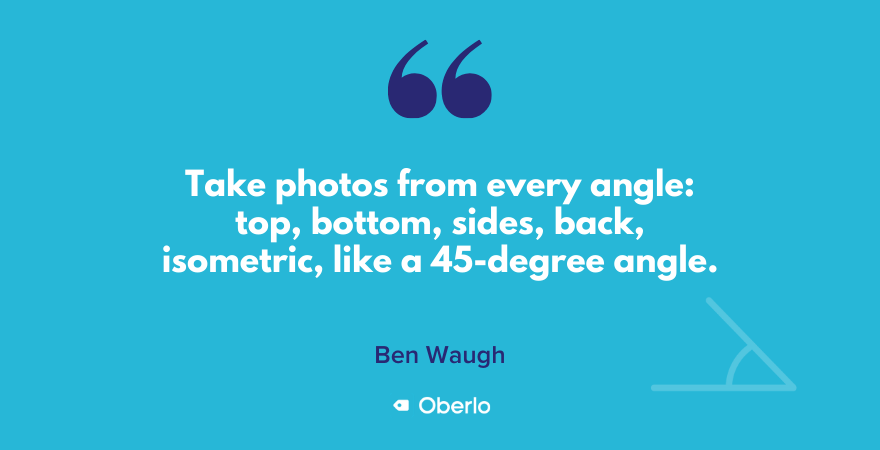
Photography for Social Media
David: Social media, of course, is integral for most online stores these days, most stores, period. So, when we look specifically at businesses that have physical products to promote, what tips would you give when it comes to featuring products on social media, without the photographs looking like they’re sales-y, or looking like some standard product shot.
What can make them seem more organic, where they might pop a little bit in a feed versus a more generic commercial pick?
Ben: I definitely do not encourage putting text on photos for social media. It’s not something that I’ve ever seen perform super well and I’ve been on both sides, where I’ve been the photographer and I’ve also been a social media manager for multiple different businesses now. And having text on images, like a massive, “Sale, 10% off,” written right at the top of the image in bright red, it doesn’t look good.
And people aren’t gonna be like, “Oh sweet, that’s a high-quality brand.” People are almost pushed away by that. I think sometimes it’s really important to… Especially on social media now, and like I was just saying, on an ecommerce store, people aren’t as interested in reading. We have such a short attention span now that you wanna really catch people very quickly.
Depending on your product, maybe it makes more sense for you to have just a product photo, with nothing else but your product on a beautiful, white background. Or maybe your product is something that you want people to take with them on a camping trip, so you might wanna actually feature that product in a scene. So, someone is camping, you can tell there’s a tent in the background or whatever, and they’re holding the item.
It really depends on who you’re trying to target, but make sure you do that well and always lead with your imagery.
I think that there are too many times where people will put text on images and it can really actually push people away.
Yeah, social media is definitely an interesting one. People have a very short attention span and depending on the social media sites you’re using as well.
If you think about the way that people use social media as well… For instance, when people wanna watch YouTube, quite often they’ll know they’re doing it. They’ll sit down and dedicate some time to watching YouTube. Maybe they pour their morning coffee and they’re like, “Alright, I’m gonna sit down for 30 minutes and watch Ben Waugh on YouTube because he’s got a new video out.”
Whereas Instagram, people are waiting for the bus, they’ve got 25 seconds and they don’t wanna interact with other human beings and they’re just gonna scroll. It’s interesting, you have to think about how people are using the platform and maybe the content that they’re trying to consume, and target that specifically for that platform as well.
And Facebook’s different. People are more inclined to spend some time to read information and post videos there too. Whereas I think, Instagram, people are quite often looking for something aesthetic and fairly quick. So, marketing on Instagram is a tricky one, you need to really jump out at people and grab their attention quite quickly. And, “Sale, 10% off,” is not the best way to do that sometimes. But you never know.
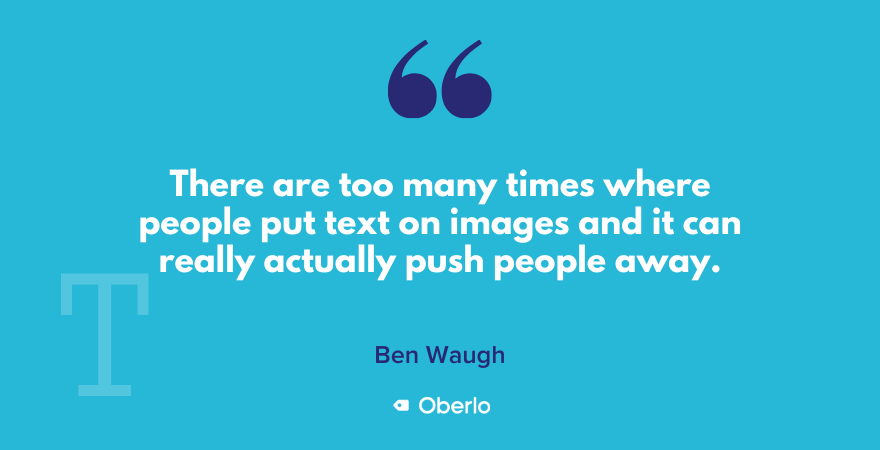
David: Do the standard or traditional rules of photography apply across all these different social media platforms? And I’m thinking specifically of a place like TikTok. And I know this is video-based, as opposed to photography. But it seems like on TikTok, and perhaps elsewhere, there’s almost an embrace of things being a little bit raw.
I know that you are an expert, you are perhaps a purist about these things and all good if that’s the case. But I wanted to take your pulse on whether there are some situations or some platforms where maybe it’s best to not edit things and to just leave it a little bit grimy?
Ben: TikTok is definitely something that’s changing how people consume media as well. But personally, on my Instagram, I found that… I have an audience of people that are quite interested in photography itself. I think a lot of people do benefit from seeing some of the more raw content sometimes too. People love seeing the before-and-afters of your photos and things like that. It can be super useful to them.
But sharing some more raw content does add a realness to your brand, regardless what it is.
And it allows people to look at it and be like, “Oh cool, you’re just a person too, that’s awesome. Me too.” Then, it doesn’t put you way above them and make them feel like they’ll never be able to achieve that, never be able to reach that, or maybe it’s out of their league.
By having a rawness or a realness to it, it does actually add a lot of personality to your brand. So, I think it’s important to not be afraid when you’re taking your photos, that they don’t need to be the best thing in the entire world, but just make sure you’re taking pride in it, but know that adding a certain level of realness and rawness does make people more… It does add more personality to your product.
Ben’s Book Recommendation
David: Sure. Alright, one more question for you, Ben. Then I’m gonna let you go wander around the rainforest. I’m curious if there are one or two things that you would suggest everybody should watch or read or listen to or subscribe to. Basically, just some content that you find particularly educational that you would recommend to anybody listening.
Ben: So one… It might not tailor to everyone, but one particular eBook that I’ve absolutely loved and it’s a hardcover book as well if that’s your thing, but it’s the biography of Elon Musk. I actually really enjoyed that one. I think it’s fantastic and it’s something that really got me amped up.
I’m not a massive reader, but listening to that audiobook while we were driving, or whether it was while I’m working, or just having some chill out time, it’s a really interesting book about trial, failure, and success, and it really made you think about the way that you do things, I think.
And it got me really amped up to just try new things and push myself. So, there are a lot of examples in that book about Elon trying to do something different and trying to push to do something that a lot of people aren’t doing and a lot of people are shutting him down, telling him he’s dumb and he’s crazy and he’s not gonna be able to do it.
And by pure resistance, he manages to get there eventually in quite a lot of these tasks and I think that’s a really important message that I’ve gotten from that that does come across into not only photography but everything else that I do, that not everything you do you’re gonna be good at immediately.
There are a lot of things that you try for the first time and you really suck at it, and that is totally okay. And it’s just like anyone out there who’s gonna be taking their own new photos for their brand or their business, or whatever you’re doing, if you’ve never taken product photos before, they’re probably not gonna be good straight away, and that’s totally fine.
That’s okay, it’s just practice and persistence, and pushing through that until you get somewhere you wanna be.
And I think that that’s a really, really good book or eBook, or however you wanna consume that media, it’s a really, really interesting one to listen to, and it’s a fantastic resource to get you amped and inspired and compare yourself to some pretty incredible business people out there.
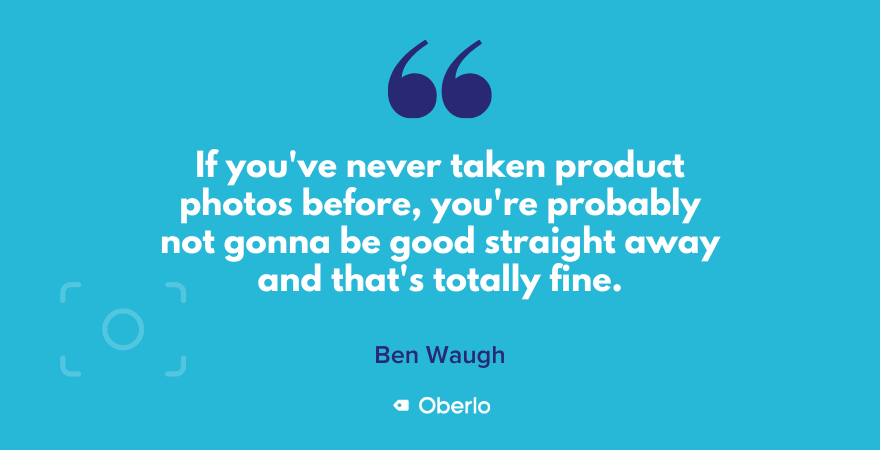
David: Perfect. That’s a perfect spot to leave it, Ben. I really appreciate you taking the time to chat. Again, you can check out Ben Waugh’s stuff on his website, benwaugh.com, his Facebook, YouTube, Instagram. We’ll link to all this stuff in the show description. But in the meantime, Ben, thank you so much.
Ben: Thank you very much for having me, it’s been awesome. I appreciate it.


